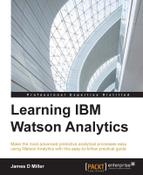Again for illustration, let's consider a sample use case and use some of the enterprise oriented concepts we discussed in this chapter.
This sample use case involves an organization that provides state-wide transportation for hire services. The group started with a couple of drivers, a car, and a van and has evolved into a large team of professional drivers offering (driving) services for individuals and specific events using a vehicle chosen from a fleet of specialized vehicles. At the request of management, all trip information is captured and saved by each driver and submitted to the main office at the end of each month as a part of the payment and expense reimbursement process. The objective is to perhaps gain some insights, such as:
- When are trip issues or unplanned events most likely to occur? For example do they most often happen on overnight trips?
- What can we expect for a tip (gratuity) based upon the run or event? For example, do corporate events or trips with multiple destinations tip better?
- Is there a relationship between the event type and vehicle type used? For example, do certain events require a certain type of vehicle?
The following information is requested in each file:
- Run Date: The date the trip began/started.
- Pickup/Drop Locations: Where the customer was picked up and dropped off (drop-off could be different from the pickup location).
- Primary and Secondary destinations: What was the planned destination(s)?
- Vehicle Type: The type of vehicle used for the trip.
- Event Type: For example, was this an athletic event, a wedding, or a corporate event?
- Trip Type: Whether or not the trip was an overnight (did the driver and vehicle not return the same day)
- Tip grade: This is not an amount. It is simply an indication of whether the customer tipped the driver consistent with the cost and effort of the service and vehicle involved.
- Customer Type: Was this a new customer, referral, or existing?
- Guide: Was a tour guide included in the trip?
- Issues: Did any unplanned events occur on the trip (an accident or illness)?
- Type of payment rendered: Was payment paid through an invoice, check or credit card?
Before jumping into Watson with our data files, let's take a moment to contemplate a few points of interest from an enterprise perspective:
- Since we are collecting and merging data from various sources (the organizations many drivers), we can expect that we may receive files in (slightly?) different formats. We will need to reformat them into a common format for Watson to process and, since we want to do this on an ongoing basis, we may continue to receive files that we'll have to again, reformat.
- In addition, management has requested that trip information be captured in MS Excel worksheets and sent by the first of the following month, but no other requirements were given to the drivers, therefore, inconsistencies in actual data values are present, requiring interpretation. For example, the field Tip Grade uses both scales Large, Medium, Small, and None, as well as a numbered scale of 3, 2, 1, and 0. Blanks are also used to mean no tip given or none. Another example is the field Overnight, where we expect the value to be Yes or No, but it seems some drivers have provided a numeric value: 0 meaning not an overnight trip, or a number greater than zero to indicate the number of nights the trip actually took.
- Finally, since any insights garnered from the process of collecting and formatting the files each month needs to be presented to management in a consistent manner, and since (most likely) this process will be performed by different individuals each time, it would be helpful to establish some method of easily identifying artifacts validated and used in prior months.
As we have demonstrated in Chapter 6, Customizing and Extending, this modeler is a very viable option for extending your Watson analytical experience. It even offers you the ability to save and reuse what you create. Reformatting fields, interpreting field values, and merging or appending files are all easily accomplished with this tool.
Furthermore, as we have demonstrated throughout this book, Watson itself supports the saving of artifacts (visualizations, for example) in a collection for later reuse.
Let's now look at our sample use case, using the previously mentioned enterprise oriented suggestions.
